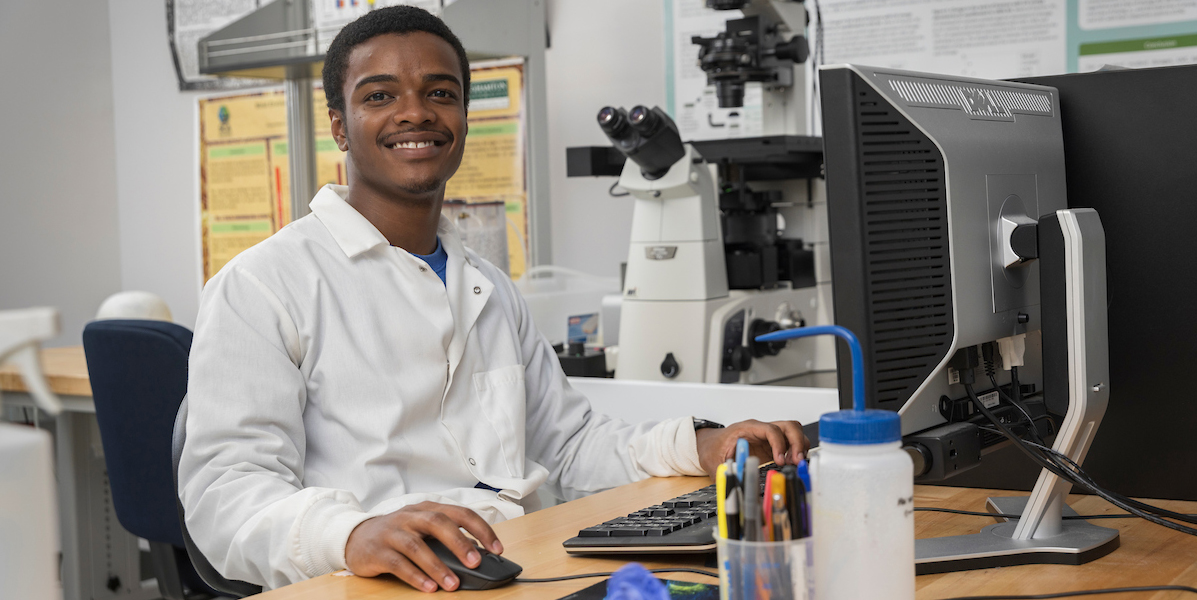Binghamton lab focuses on understanding skin

Research at Binghamton University may one day explain how to prevent wrinkles and reduce the risk of surgical site infections, and an undergrad has a role in the work.
Junior Alejandro Wiltshire has been interested in conducting research for as long as he can remember. Now he works in the Biological Soft Matter Mechanics Laboratory (BSMM) with Guy German, associate professor of biomedical engineering at the Thomas J. Watson College of Engineering and Applied Science.
“I think of it as a skin lab, even though it’s more than just that,” Wiltshire said. “It’s a very versatile biomedical engineering lab. Most of the time when people think of biomedical engineering, they think of cells or creating some sort of vaccine, whereas this is the more mechanical aspect of it. It’s a great place to learn about skin and to learn about a different aspect of mechanical engineering.”
Wiltshire joined the lab as a first-year student. With German’s guidance, he has refined his skills in research and laboratory methods.
“Alejandro is committed, rigorous, and an asset to my team,” German said. “He has integrated well with my team of graduates and undergraduates, has learned the varied techniques required for his research quickly and efficiently, and has shown me he can perform effectively independently and as part of a team.”
Wiltshire is part of two research projects. His work on the rate of infection resulting from surgical sites has broad implications in helping regions of the world where infection rates are higher than average.
“If we can figure out how bacteria enters wounds, we can hopefully prevent this from happening,” Wiltshire said. “We are hoping that through this research, we can actually improve the pre-operative procedures, in order to lower the rate of surgical site infections.”
Wiltshire examines the rate of bacterial infection by making observations through imitation. Using a powerful microscope, Wiltshire shared images of his biomechanical model in detail. A substrate plays the role of the skin, while fluorescent beads mimic bacteria.
He included visuals in the demonstration, which allowed for a deeper, more comprehensive understanding of his investigation.
“I think a lot of science is visuals, like you need to see it in order to understand it,” he said. “I’m more of a visual learner myself, so I like to show things and explain along the way.”
Wiltshire’s second project relates to wrinkle formation as a result of aging. Using a series of complicated instruments, Wiltshire works to determine the individual mechanical and structural properties of skin and how this relates to the formation of wrinkles.
The experiments use skin samples from human cadavers. Within four to six days, members of the lab conduct rigorous experimentation on the samples to gain a better understanding of how wrinkles develop over time and how collagen fibers in the skin alter the shape of the wrinkles.
As a member of an artistic family, Wiltshire knew his interests differed greatly from the people around him, but that didn’t deter him from finding a balance between his love for engineering and his appreciation for art.
“I try to take everything in my life and tie it together,” said Wiltshire, who grew up in Hempstead on Long Island. “I think my purpose was kind of trying to tie the things that I enjoy in science and STEM with the artsy side of my life and the things that I view as being artsy.”
Through his position as the STEAM chair of the Binghamton Art Club, Wiltshire hopes to bring awareness to the intersection of art and engineering, and encourage students to pursue and enjoy both paths.
Wiltshire said his experiences in the lab, including a project as part of the Summer Scholars and Artists Program in 2022, have improved his understanding of complex concepts in his undergraduate engineering classes.
“I’m not a classroom learner, I’m more of a hands-on learner,” he said. “So I’ve realized that the more time I spend in the lab, the more that I actually learn here and that I can apply it to the classroom as opposed to the other way around.”
Wiltshire hopes to pursue a doctorate in biomedical engineering at Binghamton after he graduates.
“I’m always investigating something that I didn’t know before,” he said, “and that, to me, is what I want to do.”
